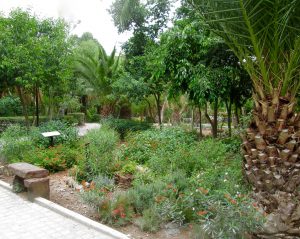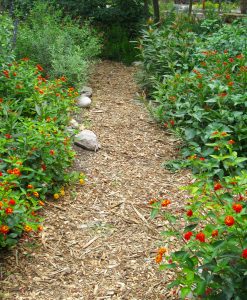Yesterday a friend and I went on a mission to “plant” a small portion of her sister-in-law’s ashes.
My friend’s sister-in-law — I’ll call her Ana — died last month at the age of 73 from an incurable terminal illness that ravaged her body over many months but left her mind intact. So Ana, who’d been a master gardener, was able to plan her end-of-life wishes in clear and loving detail.
She stipulated that after her death she wanted all the members of her large and widely dispersed family to come together at her near-beachfront home in Florida to celebrate her life over the course of several days. She wanted each family member to take a portion of her “cremains” back to their homes with them, to be buried in their own or a nearby flower garden. Her wish was to remain near her family in this way, wherever they lived, all over the States and the world.
So my friend returned from that family gathering with a small, velvet, delicately embroidered draw-string bag that one of her sisters had made for each person for this purpose, containing her portion — just a few spoonfuls’ worth — of Ana’s ashes in a tiny Ziploc bag. Since my friend, like myself, lives in an apartment here in San Miguel de Allende, Mexico, and doesn’t have a garden of her own, we had to scout around for a suitable place, one that would have surely pleased Ana.
Trusting that what we were doing was legal [if it’s not, please don’t tell], my friend and I chose what we felt was the perfect spot – in the “pollinator project” section of San Miguel’s premier green space, Parque Juarez. My friend liked the idea of the 100+-year-old Parque Juarez because, she said, it was designed in the French style “and Ana always wanted to go to France.” Plus, this section of the park, with its flowering perennial plants, was especially eco-friendly and attractive to bumblebees and Monarch butterflies, which fluttered and buzzed around us as we worked and would continue to do so for Ana.

So we dug a small hole in the soft, chocolaty soil near the base of one of the flowering plants and sprinkled the powdery contents of the small Ziploc bag into it. Then we gently covered the hole with more earth and poured some water over the area (as though Ana’s ashes were seeds that would one day grow). We then took photos for my friend’s brother, Ana’s bereaved husband, who plans to create an album of all of “Ana’s gardens” for everyone in the family.

I never met Ana – she never had a chance to visit my friend here in San Miguel – but I feel as if I knew her. I can imagine her spending time researching the various options for disposing of ashes before she made her own carefully laid plans. I can imagine that in her research she came across the same website I did, www.funeralinspirations.co.uk, and read their listing of creative ideas for “Dispersing the Ashes.”
Leave it to the Brits to put a humorous spin on this solemn subject. Besides the commonly accepted plan of putting “Aunt Maud’s ashes in a jar on a mantle piece,” they offer these alternatives (among others): Burial, as in a “garden of remembrance” (as Ana chose); To the Wind (provided that wind isn’t blowing in your face); Trenching, as in digging a shallow hole in the sand at the beach and letting the incoming tide take the ashes out to sea; Water Scattering from a private boat (see the proviso under “To the Wind” above); Fireworks (and I quote:) “If you ever wanted to go out with a bang, you won’t get much bigger than this!” and Shooting, which, they claim, is “not so bizarre” for those who really enjoyed explosives in their lifetime.
(An aside: Johnny Depp, who played writer Hunter S. Thompson in the 1998 film “Fear and Loathing in Las Vegas,” which was based on Thompson’s book, reportedly paid $3 million to have Thompson’s ashes shot from a cannon — following Thompson’s wishes — after his suicide at the age of 67 in 2005. Thompson’s widow, Anita, is quoted as saying at the time, “He loved explosions” [www.theguardian.com — Feb. 1, 2017].)
Ana was obviously a planner, and so, by nature, am I. I’m not, as far as I know (thank God), terminally ill; nevertheless, I already have plans for my ashes. I want them to be “planted” on a hilltop at a ranch not far from here in the central mountains of Mexico, in a village called Rodeo (my last rodeo!), with a 360-degree view of undulating hills and rich green pasture land.
Often here in San Miguel I tell my friends, “I’m so grateful to live in Mexico now — and not in Trumplandia — I could get down and kiss the ground.” (But of course I don’t do so.) Ah, but when I go back to the earth as ashes in Mexico, as Ana has just done, I’ll be kissing the ground every day.

Thank you dear Bonnie for writing this lovely essay about our experience with my sister-in-law’s ashes. You always seem to draw the sublime out of the experiences the rest of us would note and then walk on.
Ah, you’ve “out”‘d yourself, P.! Now, if the law comes after us, you’ll be taken in too! 🙂 Vamos a ver… — xx
Beautiful planning, planting and writing. Thank you Bonnie for sharing this special moments with us. Some years ago, I received a dear friend’s ashes from the USA. He wanted to be close to my family but also up in the Alps I so often wrote about. Both his wishes have been realized : part of him rests under a bush – yellow all year round – in our garden. The other ashes I spread in a high mountain pasture, surrounded by larch trees and facing the Alps. I guess he would have loved it.
Thank you so much for writing and sharing, dear Isabel! Yes, I think it’s important for us all to think about where we want to permanently “park” ourselves on this beautiful planet. 🙂 I’m sure your friend is grateful to rest in peace near you in Switzerland.
Love this piece Bonnie. And I bet I know with whom your ashes will be placed! I love the idea of it, and I’m sure mine will be on this side of the wall as well!
Thanks, Vanessa! Yes, you guessed it. I can’t wait to read this post to him (since he doesn’t have e-mail anymore). He’ll be stuck with my ashes forever! 🙂 Viva Mexico, verdad.
My maternal cousins, two good women trying to plant their mom’s ashes in a suitably iconic place, chose an estuary on the Oregon coast near their mom’s ho9me in Medford. But standing on the marshy bank, they didn’t account for the winds, which blew their mom right back in their faces.
My wife and her sister, trying to secrete their mom’s ashes on her favorite trail, which was illegal because it was publicly owned, tried to shake one of the grandchildren who had followed them. Just as they did the deed, he came up and asked loudly, “Are you burying somebody?”
That’s funny, Steve! Yes, I’m now learning lots of family stories such as this — blowbacks and clandestine digging… This turns out to be a large and many-faceted subject! I didn’t even mention becoming compost or mulch. 🙂
Thanks for the upper. Enough downers already.
Thanks, Pat. I’m not normally noted for my “uppers.” 🙂